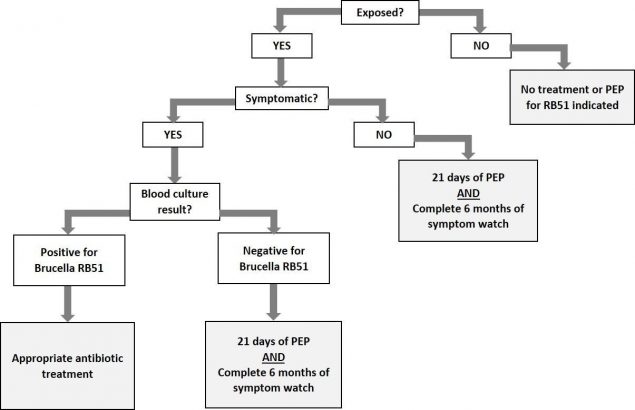Third Case of Rifampin/Penicillin-Resistant Strain of RB51 Brucella from Consuming Raw Milk
Distributed via the CDC Health Alert Network
January 23, 2019 1430 ET (2:30 PM ET)
CDCHAN-00417
Summary
The New York State Department of Health and Pennsylvania Department of Health are investigating Brucella RB51 exposures that may be connected to consuming raw (unpasteurized) milk from Miller’s Biodiversity Farm in Quarryville, Pennsylvania. Symptoms of brucellosis can include fever, sweats, malaise, anorexia, headache, fatigue, muscle and joint pain, and potentially more serious complications (e.g., endocarditis, hepatomegaly, splenomegaly, and neurologic symptoms). In pregnant patients, Brucella infections can be associated with miscarriage. Symptom onset can occur anywhere from five days to six months following exposure. As of January 22, 2019, exposures have been identified in 19 states: Alabama, California, Connecticut, Florida, Georgia, Iowa, Maryland, Massachusetts, Michigan, Minnesota, Mississippi, New Jersey, New York, North Carolina, Ohio, Pennsylvania, Rhode Island, South Carolina, and Virginia.
Background
This investigation is associated with the third known case of brucellosis from Brucella RB51 due to raw milk acquired in the U.S., since August 2017. A New York resident, who drank raw milk purchased from Miller’s Biodiversity Farm in Quarryville, Pennsylvania, was diagnosed with brucellosis in November 2018. Milk samples from the dairy tested positive for Brucella strain RB51. People who consumed raw milk or raw milk products from this dairy since January 2016 may have been exposed.
- Patients who are still within six months of the date they last consumed the raw milk are at an increased risk for brucellosis and appropriate post-exposure prophylaxis (PEP) is recommended, along with six months of symptom monitoring. Please see diagram below.
- If patients are outside of the six-month window following their last consumption of the raw milk and have or develop an illness consistent with brucellosis, a blood culture should be obtained prior to starting any treatment, preferably while the patient is symptomatic.
Brucella strain RB51 is a live-attenuated cattle vaccine strain, which can be shed in milk and can cause infections in humans. RB51 is resistant to rifampin and penicillin. There is no serological test available to detect RB51 infection. Blood culture is the recommended diagnostic test for exposed individuals who are symptomatic.1
Recommendations
The Centers for Disease Control and Prevention (CDC) recommends the following:
- A 21-day course of both doxycycline and trimethoprim/sulfamethoxazole for first-line PEP for RB51 exposure.2 If brucellosis occurs despite prophylaxis, treatment should be pursued; alternative options should be considered for those with contraindications to the stated PEP and treatment regimens.2 Please note that RB51 is resistant to rifampin and penicillin.
- When ordering blood cultures to diagnose brucellosis, please advise the laboratory that blood culture may grow Brucella and that appropriate laboratory containment and precautions should be observed.3
- Advise patients to discard any leftover or stored, raw milk or raw milk products from this dairy farm.
Please see the diagram below for information on developing an evaluation and treatment plan for patients who consumed raw milk or raw milk products from Miller’s Biodiversity Farm since January 2016, and are still within the six-month window following their last known exposure.
Treatment Decision Tree for Patients Who Consumed Raw Milk or Raw Milk Products
from Miller’s Biodiversity Farm in Quarryville, Pennsylvania

Note: Testing for asymptomatic patients is not recommended.
References
1Laboratory Diagnostics – RB51
- Schurig GG, Roop RM, 2nd, Bagchi T, Boyle S, Buhrman D, Sriranganathan N. Biological properties of RB51; a stable rough strain of Brucella abortus. Vet Microbiol. 1991 Jul;28(2):171-88.
- Cossaboom CM, Kharod GA, Salzer JS, Tiller RV, Campbell LP, Wu K, et al. Notes from the Field: Brucella abortus vaccine strain RB51 infection and exposures associated with raw milk consumption – Wise County, Texas, 2017. MMWR Morb Mortal Wkly Rep. 2018 Mar 9;67(9):286.
2Treatment of Brucellosis
- Ariza J et al. 2007. Perspectives for the treatment of brucellosis in the 21st century: the Ioannina recommendations. PLoS Med. 4(12): e317. http://www.plosmedicine.org/article/info:doi/10.1371/journal.pmed.0040317
- Al-Tawfiq JA. 2008. Therapeutic options for human brucellosis. Expert Rev Anti Infect Ther. 6(1): 109-120. http://www.ncbi.nlm.nih.gov/pubmed/18251668
- Solera J. 2010. Update on brucellosis: therapeutic challenges. Intl J Antimicrob Agent. 36S, S18–S20. http://www.ncbi.nlm.nih.gov/pubmed/20692127
3Biosafety in Microbiological and Biomedical Laboratories https://www.cdc.gov/labs/pdf/CDC-BiosafetyMicrobiologicalBiomedicalLaboratories-2009-P.pdf
For More Information
Risks from Unpasteurized Dairy Products
https://www.cdc.gov/brucellosis/exposure/unpasteurized-dairy-products.html
Exposure to RB51 through Raw Milk or Milk Products: How to Reduce Risk of Infection
https://www.cdc.gov/brucellosis/clinicians/rb51-raw-milk.html
Symptoms of Brucellosis
https://www.cdc.gov/brucellosis/symptoms/index.html
Brucellosis and Expecting Mothers
https://www.cdc.gov/brucellosis/exposure/expecting-mothers.html
Raw Milk Questions and Answers
https://www.cdc.gov/foodsafety/rawmilk/raw-milk-questions-and-answers.html
Brucellosis Reference Guide
https://www.cdc.gov/brucellosis/pdf/brucellosi-reference-guide.pdf
For general, non-urgent inquiries during business hours (8:00 AM to 8:00 PM EST):
CDC-INFO
https://www.cdc.gov/cdc-info/index.html or 1-800-232-4636
For emergencies, 24/7:
CDC Emergency Operations Center (EOC)
770-488-7100
For clinicians and health departments during business hours (8:30 AM to 4:30 PM EST):
Bacterial Special Pathogens Branch
bspb@cdc.gov or 404-639-1711
The Centers for Disease Control and Prevention (CDC) protects people’s health and safety by preventing and controlling diseases and injuries; enhances health decisions by providing credible information on critical health issues; and promotes healthy living through strong partnerships with local, national and international organizations.
Department of Health and Human Services
HAN Message Types
- Health Alert: Conveys the highest level of importance about a public health incident.
- Health Advisory: Provides important information about a public health incident.
- Health Update: Provides updated information about a public health incident.
###
This message was distributed to state and local health officers, state and local epidemiologists, state and local laboratory directors, public information officers, HAN coordinators, and clinician organizations.
###

